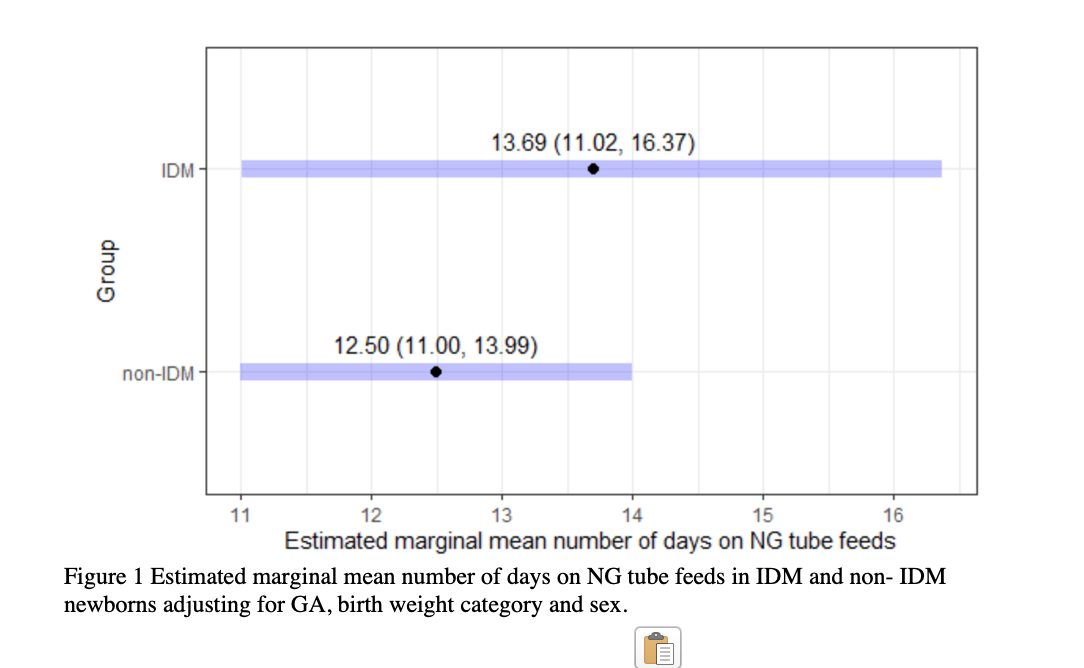Neonatology
Session: Neonatal General 3: Maternal and Fetal Medicine
81 - Feeding Difficulties in Infants of Diabetic Mothers
Friday, May 3, 2024
5:15 PM - 7:15 PM ET
Poster Number: 81
Publication Number: 81.17
Publication Number: 81.17
- JA
Joanne Amos, DO
Neonatal Perinatal Fellow
Georgetown University School of Medicine
Nemours/Alfred I duPont Hospital for Children
Arnold, Maryland, United States
Presenting Author(s)
Background: It is ‘common knowledge’ among clinicians that Infants of Diabetic Mothers (IDM) have feeding difficulties, but this has never been measured systematically.
Objective: The objective of this study is to characterize and quantify the severity of feeding difficulties in the neonatal period in IDM.
Design/Methods: In this IRB approved retrospective cohort study, data from electronic medical records of all IDM born at >34 weeks’ gestation from 4/1/2017 to 3/20/2022 at MedStar Georgetown University Hospital were analyzed using student t-test, chi square, Fisher exact test and negative binomial hurdle regression. Feeding difficulty was defined as needing tube feeds to ensure intake in infants without respiratory distress or support. Infants who were post-ECMO or whole-body cooling, severe congenital malformation requiring surgery, or other severe illnesses were excluded.
Results: Of 475 IDM included, 425 were born at ≥37 weeks gestation (term IDM), and 50 at 34 - 36 6/7 weeks of gestation (late preterm IDM).
Of the 425 term IDM, 88 (20.7%) were admitted to the NICU and 22 (25%) of them had nasogastric (NG) tubes placed initially due to respiratory distress. The median length of time for NG feeds after respiratory distress resolved was 4 days (IQR 6.25 days). Two infants required prolonged NG tube feeds, one for 25 days and another was discharged home with an NG tube after 46 days of NG feeds in the NICU.
Among 277 late preterm newborns admitted to the NICU, 50 were IDM, and 227 were born to non-diabetic mothers. Table 1 shows there was no statistically significant difference in the number of days of NG tube feeds in both groups. The median number of days on NG tube feeds was 11 days in the IDM group compared to 13.5 days in the non-IDM group. Two IDM required gastrostomy tubes after 51 days (Odds Ratio 23.45 (95% CI 1.1-496.3), after 42 weeks corrected gestation. After adjusting for gestational age, sex and weight, group (IDM vs. non-IDM) did not have a significant effect on length of NG tube feeds (Fig.1).
Conclusion(s): In this study, only 2 of 425 term IDM required prolonged NG tube feeds. It is difficult to compare this with non-IDM term infants in the NICU due to the diversity of illnesses.
In late preterm newborns, there was no significant difference in the number of days of NG tube feeds in IDM versus non- IDM newborns admitted to the NICU, but two infants in the IDM group required gastrostomy tube placement after 51 days.
There appears to be a small but significant risk of needing gastrostomy feeds in late preterm IDM.
.png)

